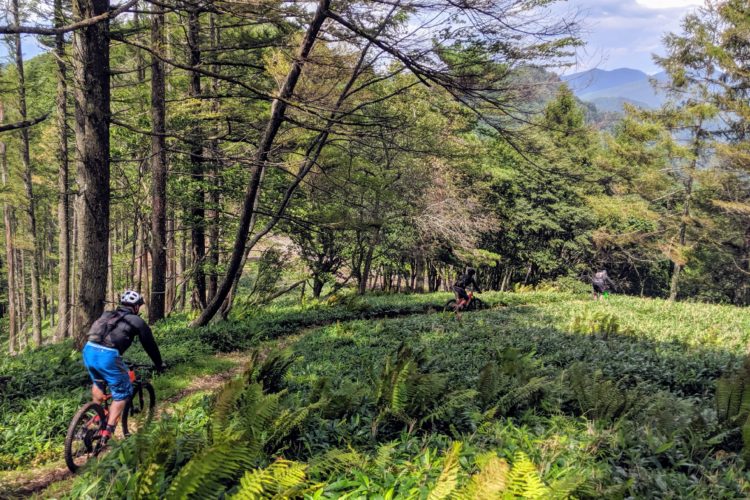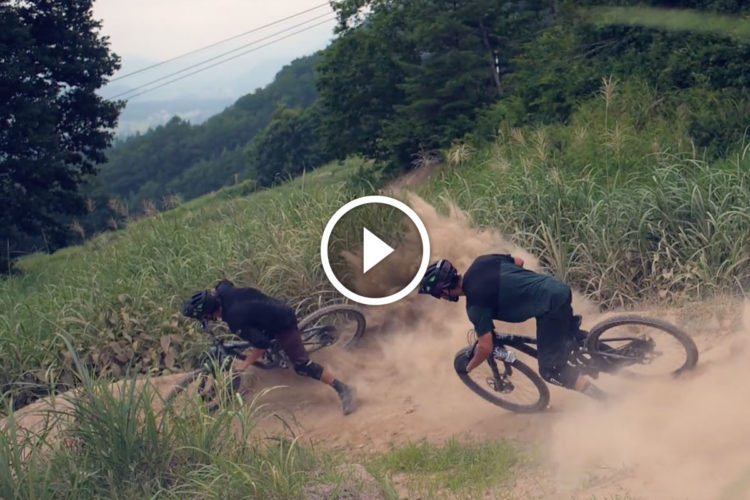
This isn’t a truly universal statement, but it is common that in most places around the globe known for great skiing in the winter, there is a mountain bike trail counterpart in the summer. Think of Whistler, the Rocky Mountains, Tahoe, the French, Swiss and Italian Alps, and so many other places.
And then there is Japan, the off-the-beaten path ski destination where Westerners flock. Winter trips usually mean airy, hip-deep powder through sparse trees, and buckets of ramen noodles for aprés. But, maybe to much surprise, six months later in the summer, the opportunities for mountain biking in the Japan pale in comparison to the handfuls of ski resorts and powder access on both the mainland and the northern island of Hokkaido.
That’s something that Allegra, a Swiss company that specializes in mountain bike trail development, consulting, and tourism all over the world is trying to change. Allegra has been involved in trail building projects all over the world and started their Japan chapter last year after growing interest and demand.

How to build a mountain bike culture in Japan
It might seem strange that mountain biking has been mostly dormant in Japan since the largest bicycle components manufacturer was started there and the country hosted three downhill World Cups in 1998, 2000 and 2001. But the reality is that most people use bikes as a means of transportation and not for recreation.
“And certainly, road is a lot more accessible, especially in Tokyo,” said Marc Wyckmans, Allegra’s business development manager for Japan. “So there’s a population of road cyclists. But then when it comes to actual mountain biking as a sports recreation activity, the lack of facilities, the lack of trails, the lack of infrastructure really hinders the visibility or the access to that sport. So that’s kind of where we have to start, if we’re gonna try and improve mountain biking culture, it’s creating easy access to well-designed trails.”

Allegra has been busy so far; building flowy singletrack with the help of Community Trail Design in Fukuoka on the southern Kyushu Island, in the major Tokyo suburb of Yokohama, and in the winter powder destination of Niseko, on the northern island of Hokkaido to name a few.
Demand for these trails has come from within Japan, Wyckmans says, from mountain bikers who are limited in trail opportunities, from bike manufacturers who want to sell more bikes in the country and from private businesses or investors. Most mountain bike access in Japan has been limited to ski resorts with a few trails open in the summer, and riders are strapped for public trail systems.

The trails have to be legal
Wyckmans says that aside from creating publicly accessible mountain bike trails and skills parks, they’ve got to raise awareness about the trails that are available. Though some outsiders might assume that everything in the country is tidy and lawful, there are illegal trails just like nearly everywhere else. And like everywhere else, people try to keep them secretive.
Wyckmans has been in the situation with local riders many times where they agree to show him a great trail, as long as he doesn’t share the ride to Strava or tell anyone else.
“Because it’s such a sort of ‘protect my little trail that only I can ride,’ because as more people ride it, then I’m gonna have to deal with control, gonna have to deal with making this an official trail. We’re not there yet. So all that knowledge is kept very, very secret and it’s still very much a sort of boys club in that sense. None of these trails, none of these places that you can ride are put up on the internet for people to know about.”
Everything that Allegra has its hands on will eventually be visible online somewhere.
Many of the trails that have grown popular with mountain bikers tend to be old hiking trails that have lost popularity, but when there are hikers, there is conflict sooner or later and then a vocal opposition group.
Wyckmans has found hits and misses in working with land managers around the country to gain mountain bike access. There are common public areas and open spaces which tend to be easier to build trails, but unfortunately land managers in charge of forestry plots have been unreceptive, as their relationships with mountain bikers have been limited so far.
Old forestry areas that have become public land however, do work in a sense, and Wyckmans says the application process is simpler. With old logging roads in place, there’s already a foundation for infrastructure. These old roads can be converted to trails, however that doesn’t make for the most sustainable or enjoyable singletrack out there.
Much like certain areas in the United States, working with private land owners who have less red tape has moved more quickly.

Trails also need to look fun
The benefit of working with a group like Allegra is that the operators have witnessed the evolution of mountain bike trails globally, from the hardcore, old hiking trails that became the early stomping grounds for riders to the new age, fun-for-everyone flow trails that are essentially commonplace in almost every new trail network. One of these trails happens to be more appealing to new riders.
“So that’s what the majority of the trails that we are building are like, because that’s what needs to be here because there’s none of that,” said Wyckmans. “Everything else is sort of unofficial trails. And that’s where most of the riding’s done in Japan: old hiking trails, old forestry roads that have somehow been converted into some sort of trail. It’s not the same experience as a well designed flow trail. So you [build] one of those. And it’s amazing, people are like, wow, what’s this? This is just like what I see on TV. But now I can experience it in my own country. It’s fantastic.”
Flow trails also help alter an old perception of the sport that some may have: that it is high-risk and dangerous, when in reality, riding can be enjoyable and safe.
When more people start riding, Allegra will need to ensure there is a continuum or progression of trail difficulty so riders don’t become bored.

Culture and etiquette
Wyckmans recalled a story where a newly built mountain bike trail directly collided with Japanese cultures and customs. Allegra was working on a new trail project and the singletrack began at a shrine. Typically at the entrances to shrines in Japan there are torii gates: the red, squared arches most of us have seen. Since shrines are considered sacred, the gate marks the transition into the godly realm and there are customs when visitors pass through the gates, into the shrine.
Some residents and visitors might not have taken issue with the intersection of the beginning of the trail and the torii gate, but some did and there were formal complaints. Eventually came a rule, where mountain bikers had to dismount, walk through the park, and then get on their bike again.
“So that’s a really interesting situation to have,” he said. “That’s a unique problem and what is the difference of why, walking my bike is OK, but riding my bike is not OK? Why did the trail have to be put in that position? Anyway, these are the kinds of considerations that need to go into the early stages. The worst way to go about it is to just start riding up and down the shrine and then it becomes an issue. People are angry about it. There’s outrage. You’ll never make progress in a positive sense coming from that starting point.”


Delivering a great trail product
A few months ago, my wife and I traveled 6,000 miles from Colorado to Japan with some friends during “Japanuary,” the few week period between late January and mid-February. So did at least four other friends and their friends in the same weeks, all in search of the endless “Japow” powder brought on by cold temperatures and storms coming in from Siberia.
To our surprise and discredit to the media representation of endless powder, we instead had several bluebird days of snowboarding on sometimes icy, packed powder. We met other Coloradans and folks from the States and Canada who had also made the journey only to get skunked. Of course, when we returned home, we had an excellent powder day in the Rockies and watched social media posts of the storms Japan had received since.
“It’s like going on a beach vacation and getting rained on,” our friend quipped. The snowboarding may have been sub-par, but the trip was well-worth the expense and 13 hours of flying each way.
I asked Wyckmans if he thought eventually mountain bike trails in Japan could hold the same power and beckon hordes of Westerners to visit the mountains in the summer. It’s a hot topic for Allegra, he said.
“How do these facilities and infrastructure benefit the community not just domestically, but drawing an international market? And tourism is both domestic and international if you want to make a successful destination. You need to have foreigners coming in and enjoying your facilities. Now, what that’s going to look like in Asia in the short term is gonna be other nearby Asian countries coming to enjoy sports.”
That means it might be more people traveling from Hong Kong, Taiwan, or South Korea to experience modern mountain biking in Japan since those countries are much closer than North America or Australia.

“That’s what international tourism for Japan mountain biking is going to look like in the short term, I would say. And then you can sort of branch out.”
Mostly what made our vacation excellent despite the lack of powder was going out for ramen and saké after a day on the mountain, visiting a castle, or temple on an off-day and exploring restaurants and temples all around Tokyo. It was impossible to be sour about bad snow.
Wyckmans says that’s a point of conversation in trail building. How can they weave in some culture with the trail experience? Maybe the trail finishes at an inn or onsen or there is delicious cuisine close by.
They’ll also look to the image of skiing in Japan and see how to replicate it for a different sport, but he cautions it’s not a copy/paste formula. After all, the feeling of carving a line in fresh white powder versus carving picturesque, loamy berms are two very different things. When it’s time, they’ll need to build great trails.
“So if we can make fantastic trails, then that’s what the appeal for those international tourists is gonna be,” said Wyckmans. “So it’s really a similar approach to what domestic tourism would look like, is having a really great product that’s gonna appeal to those guys. And then again, working with the tourism board here to promote Japan as a viable mountain bike destination. The same approach that we took for the ski marketing and the ski side of things. It’s a pattern that’s well established. And I think that if you apply the same methodology to it, it’s going to be successful in Japan as well.”



















